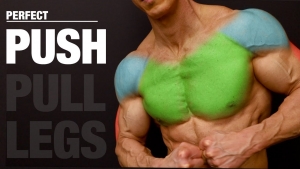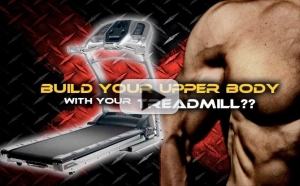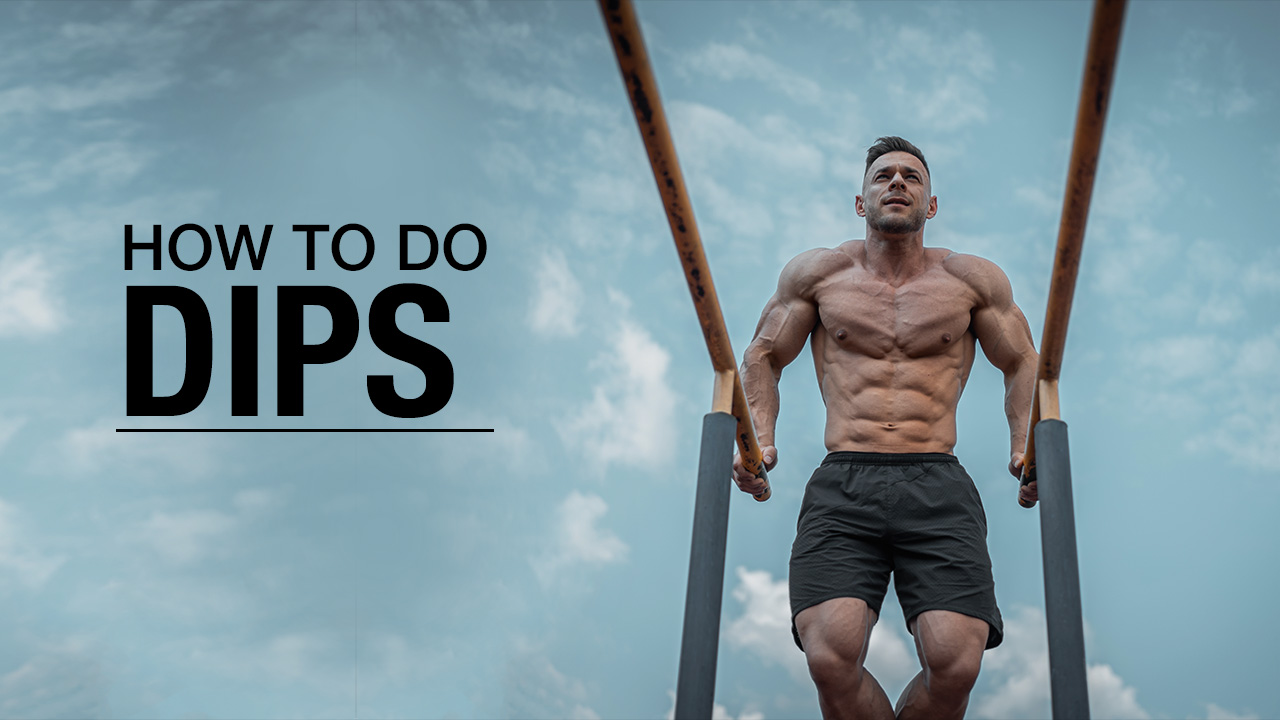
ARE YOU DOING DIPS CORRECTLY?
Most people aren’t using their chest muscles effectively when they perform the Dips exercise.
And I think that’s the biggest problem when it comes to Dips: People confuse it with a triceps Dip exercise.
Sure, it’s important to build stronger triceps, but not during a Chest Dip. Save the triceps exercises for Arm Day.
The triceps and shoulders often dominate the dip movement, and this can lead to common mistakes and poor form.
This not only hinders your progress but also puts your shoulder joints at risk of injury.
Today, I want to show you how to do Dips correctly to build a more muscular chest.
There are four things you’ll need to do and make sure you’re doing them on every rep.
It’s crucial for both the safety of your shoulders—because improper form can cause significant pain issues—and to maximize muscle activation where it counts.
By the end of this guide, you’ll be able to safely and effectively integrate Dips into your upper-body exercise routine for maximum strength and muscle gains.
DIPS EXERCISE: MUSCLES WORKED
When it comes to the Dips exercise, understanding which muscles are worked is essential for maximizing your results.
The primary muscles targeted during Dips are the chest muscles, but you’ll also get some activation in the triceps and shoulder muscles.
However, many people make the mistake of not fully engaging these muscles due to a lack of mind-to-muscle connection.
This connection is crucial—it ensures that you’re activating the correct muscles and performing the exercise with proper form.
The Dips exercise is a compound exercise that uses body weight to significantly boost upper-body strength, but only if you do it right.
By focusing on the mind-to-muscle connection, you’ll engage the pectoralis major, triceps brachii, and deltoids effectively.
This not only helps in building muscle mass but also in preventing injuries.
Whether you’re using a dip station, gymnastic rings, or sturdy benches, the key is to maintain proper dip position and a 90-degree angle at the elbows.
This ensures a full range of motion and optimal muscle activation. Neglecting this can lead to common mistakes like shoulder pain, poor form, and limited muscle gains.
So, let’s dive into the specifics of which target muscles are worked and how to engage them properly to get the most out of your dip exercises.
Starting with the chest: The pectoralis major muscle comprises three distinct parts, with fibers running in different directions.
This common variation occurs because each part originates from different areas of the clavicle and sternum.
UPPER CHEST FIBERS (CLAVICULAR HEAD)

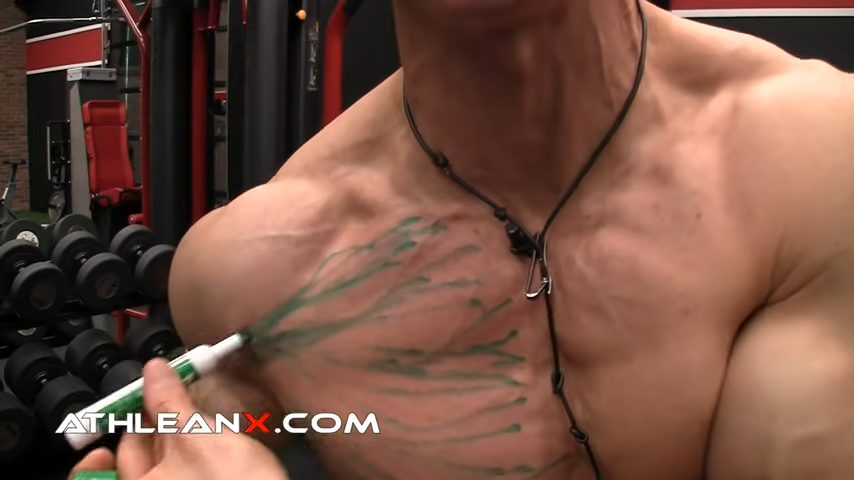
The upper chest fibers, known as the clavicular head of the pectoralis major, originate from the clavicle and extend toward the humerus.
These fibers run upward and diagonally toward the center of the chest. This section of the muscle plays a crucial role in several upper-body exercises.
The clavicular head is primarily responsible for flexing the humerus, which means it helps in raising your arm in front of your body.
It also assists in horizontal adduction, bringing your arm across your chest, and in medial rotation, which is rotating your arm towards the body.
Engaging these upper chest fibers effectively can enhance the overall definition and strength of your upper chest, contributing to a well-balanced and powerful upper body.
By targeting the clavicular head during exercises like Dips, Incline Bench Presses, and specific Chest Fly variations, you can ensure comprehensive development of your pectoral muscles and improve your performance in various upper-body movements.
MID CHEST FIBERS (STERNAL HEAD)

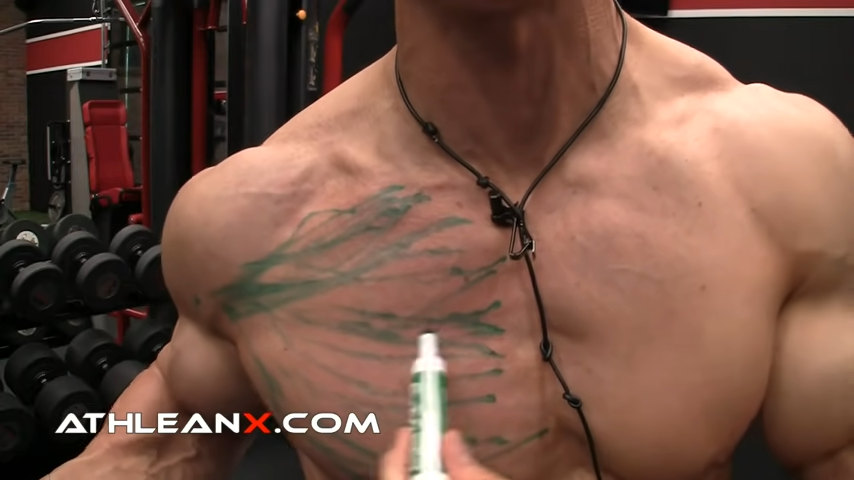
The mid-chest fibers, known as the sternal head of the pectoralis major, originate from the sternum and are oriented horizontally, running almost straight across the chest.
These fibers are important for several key upper body functions and exercises.
The sternal head is primarily responsible for horizontal adduction, which involves bringing your arms together in front of your chest.
This action is vital in many common exercises such as the Bench Press, Chest Fly, and various Push-Up variations. Additionally, these fibers contribute to the internal rotation of the humerus, which means they help rotate your arm inward towards the body.
When performing Dips, it’s important to engage the sternal head properly to maximize muscle activation and ensure balanced chest development.
LOWER CHEST FIBERS (ABDOMINAL HEAD)

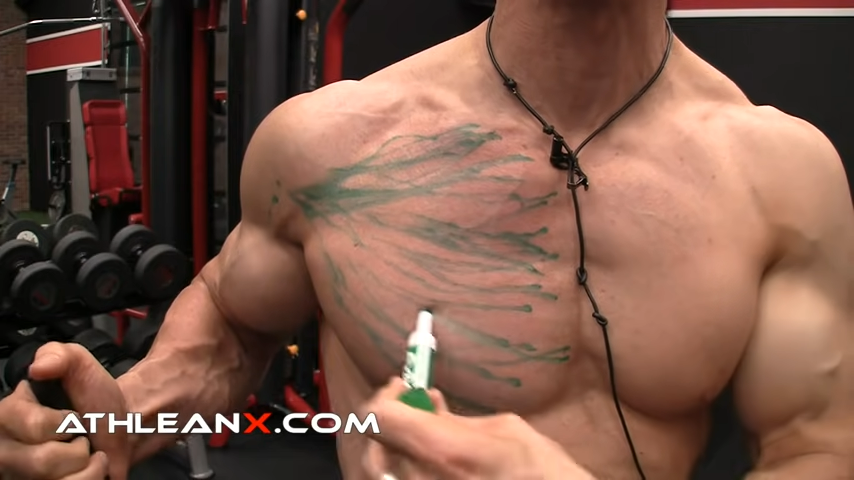
The lower chest fibers, known as the abdominal head of the pectoralis major, originate from the bottom of the sternum and travel diagonally downward towards the center of the chest.
These fibers play a crucial role in several upper body movements and are essential for achieving a fully developed chest.
The abdominal head is primarily responsible for movements that involve bringing the arm down and across the body, known as diagonal adduction.
This part of the muscle also aids in shoulder extension, helping to pull the arm back from a flexed position, and in internal rotation, rotating the arm towards the body.
Engaging the lower chest fibers effectively can enhance the overall strength and appearance of the lower part of your chest.
To target these fibers during your workouts, exercises like Decline Bench Press and Dips, and certain Push-Up variations are particularly effective.
SHOULDERS
While it’s not the primary muscle engaged, the shoulders – specifically the front delt – play a supportive role when performing Dips.
FRONT DELT (ANTERIOR DELTOID)

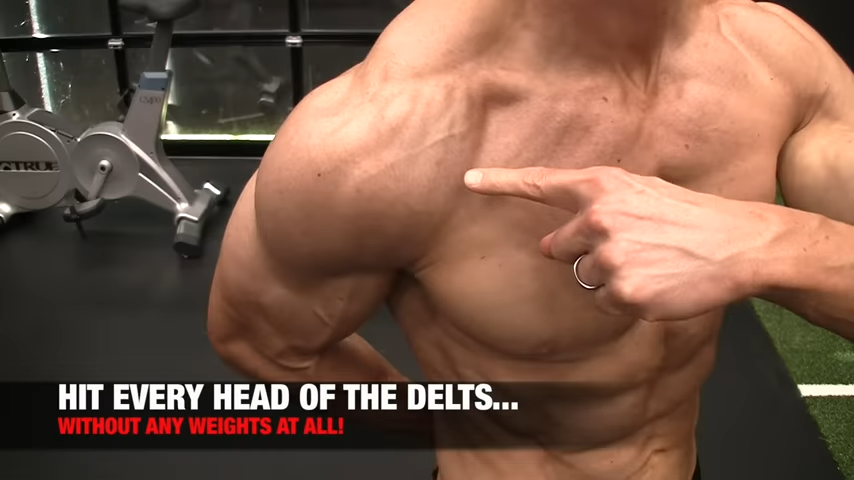
The front deltoid muscles originate from the lateral third of the clavicle and attach to the deltoid tuberosity of the humerus.
These muscles are primarily responsible for shoulder flexion, lifting the arm in front of the body.
They also aid in medial rotation, rotating the arm inward, and horizontal adduction, moving the arm across the chest.
Effective engagement of the anterior deltoids is essential for exercises like Front Raises, Overhead Presses, and variations of Push-Ups or Bench Presses.
Maintaining a stable position and correct body angle during movements maximizes muscle activation and reduces pressure on the shoulder joints.
Incorporating a mix of bodyweight exercises, such as Dips and Push-Ups, and weight-based exercises, like Dumbbell Front Raises and Barbell Presses, ensures comprehensive development of the anterior deltoids.
Using equipment like dip stations and gym benches can vary the angles and range of motion, enhancing the effectiveness of your workouts.
TRICEP MUSCLES
Another muscle group that helps out during the Dips exercise is the triceps muscle:
LATERAL HEAD

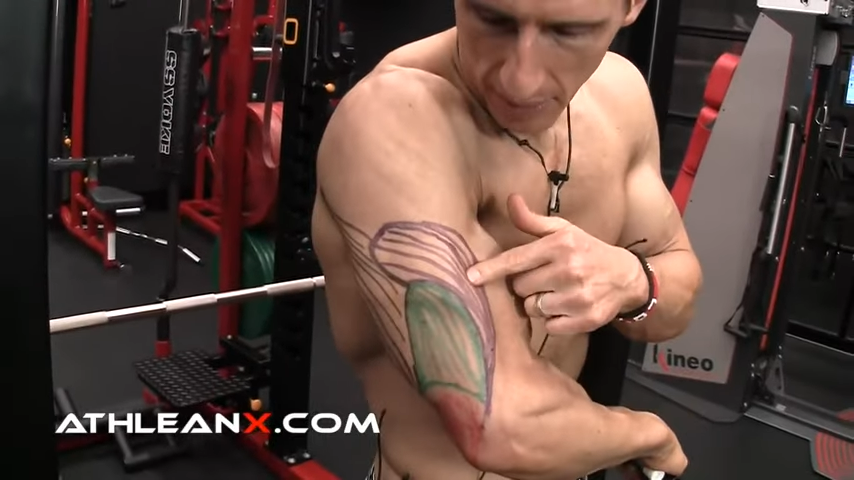
The lateral head of the triceps, located on the outer part of the upper arm, is crucial for upper body strength and muscle definition.
This muscle originates from the humerus and inserts into the olecranon process of the ulna, contributing to the overall mass and power of the triceps.
The primary function of the lateral head is elbow extension, which involves straightening the arm. This makes it essential for exercises like Tricep Dips, Pushdowns, and different forms of press movements.
Engaging the lateral head effectively is key to maximizing muscle activation and achieving balanced upper body workouts.
To target the lateral head of the triceps, perform Dips, Close-Grip Push-Ups, Tricep Pushdowns, and Triceps Extensions (Skull Crushers).
MEDIAL HEAD


The medial head of the triceps, located on the inner part of the upper arm, is essential for upper body strength and stability.
This muscle originates from the humerus and inserts into the olecranon process of the ulna, playing a vital role in the overall functionality and endurance of the triceps.
The primary function of the medial head is elbow extension, which involves straightening the arm.
Engaging the medial head effectively is important for maintaining proper form and reducing the risk of elbow injuries.
To target the medial head of the triceps, you can perform Triceps Dips, Close-Grip Push-Ups, Tricep Pushdowns, and Overhead Tricep Extensions.
LONG HEAD

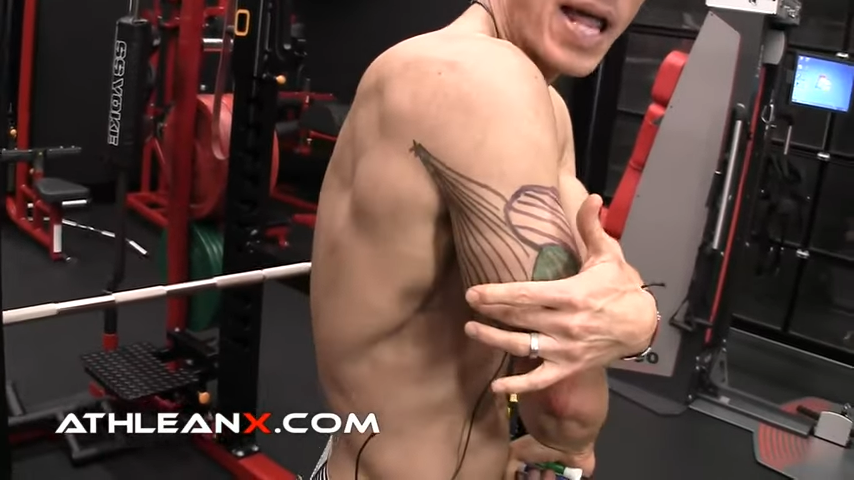
The long head of the triceps originates from the infraglenoid tubercle of the scapula and inserts into the olecranon process of the ulna, contributing significantly to the overall size and power of the triceps.
The primary functions of the long head include elbow extension and shoulder extension, which involve straightening the arm and moving the arm backward, respectively.
This makes it essential for exercises like Tricep Dips and Overhead Tricep Extensions.
To target the long head of the triceps, use a mix of challenging bodyweight exercises, such as Dips and Pull-Ups, and weight-based
exercises, like Overhead Tricep Extensions and Close-Grip Bench Presses.
DIPS EXERCISE: MOST IMPORTANT TIPS
As I mentioned above, there are four key things you’ll need to know how to do in order to perform this exercise correctly.
And these are things that you probably don’t think about.
Most guys jump up on a Dips station and start cranking out reps. If that’s you, I want you to stop and take a step back.
Start with checking your form and practicing these four tips in order to maximize muscle activation while protecting your shoulders.
POSITION YOUR CHEST

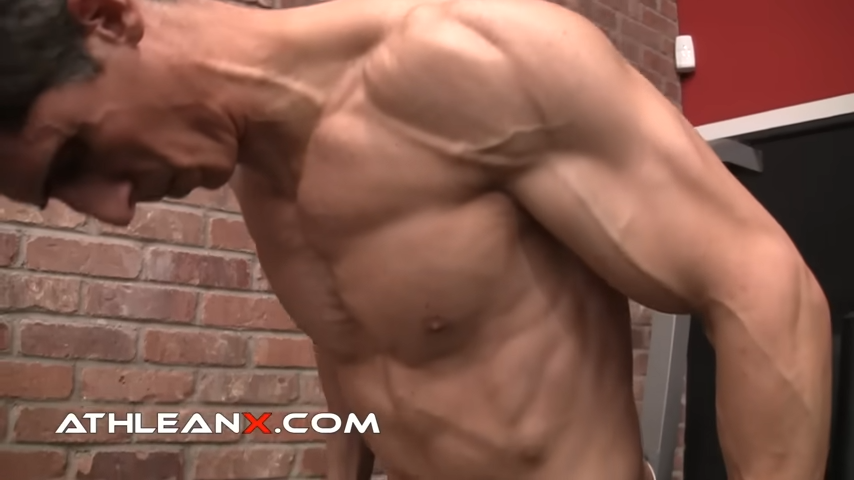
First, when you get set up for the dip, before you even go down into your first rep, position your body correctly.
You’ve heard me talk about this before.
I want you to slide your body and chest forward. Slide your body through your arms. What that will do is place your chest in front of your shoulders.
Whatever muscle is out in front is going to bear that load a lot more directly.
So, if you allow your shoulders to round and get in front of your chest, you’re asking for your shoulders to do more of the initial push out of the bottom of a dip.
This means less work and less growth for your chest.
To maximize chest activation, get your chest out in front of the shoulders.
At the same time, position your body in an anterior, or tilted forward position.
Why?
Because when doing Dips, you’re essentially performing a suspended pushup.
If you could do Dips suspended in midair, it would look like a pushup on the ground. That’s what puts most of the work on the chest itself and positions you to work the chest the most.
What you don’t want to do is go from a leaning forward position at the bottom to an upright position at the top, then back down again. This is a dangerous position to put yourself in:


This sliding motion does a horrible number on the anterior capsule of your shoulder, increasing the risk of injury. Avoid this at all costs.
Once you get into that forward-tilted position, stay there.
Imagine you’re doing pushups suspended in air, maintaining a stable position throughout the entire exercise.
This will not only help in building strength but also ensure proper muscle activation and reduce the risk of shoulder pain.
And guys, this goes for all dip variations such as Bodyweight Bench Dips, Dips on rings, and using different equipment like the dip machine or sturdy chairs for Chair Dips.
Now, for those looking for more advanced variation exercises, adding weight plates or using a weight belt can increase resistance and enhance muscle gains.
But, before you do that, you need to master exercise form.
Remember, maintaining proper form and a strong mind-to-muscle connection is crucial for maximizing results and preventing injuries.
STABILIZE YOUR SHOULDERS

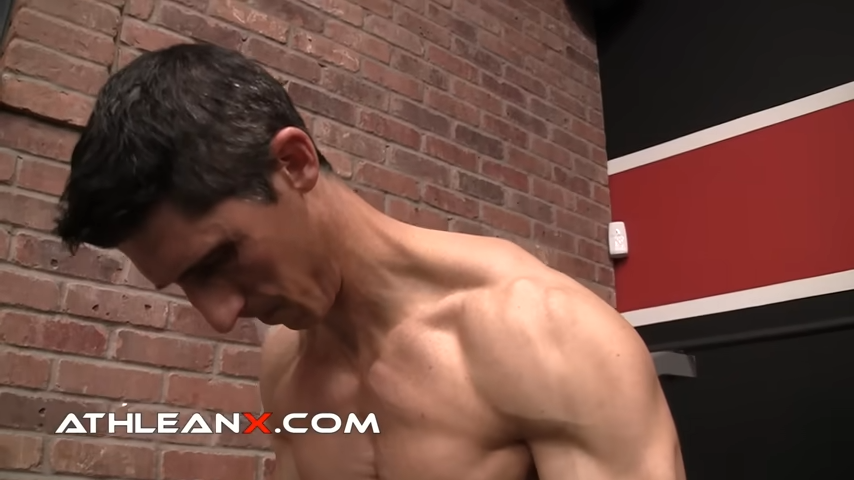
Now, we want to provide more stability through the shoulder because it’s crucial to minimize the risk of injury during different forms of Dips.
Here’s how to do it right:
Set your shoulder blades in the proper position by depressing them at the top. Don’t let yourself sink into the dip.
A common mistake people make is allowing their traps to ride up toward their ears. This can lead to shoulder pain and improper muscle activation.
To stabilize your shoulders for safety, actively push down and depress your shoulder blades.
Maintain this stable position throughout the entire exercise.
If you notice your shoulders starting to creep up as you fatigue with this burnout exercise and can’t support your own body weight (let alone additional weight), it’s times like this that I want you to cut your reps short and stop your set.
This could indicate that your serratus anterior is weak and needs to be strengthened.
I can’t say this enough:
Whether you’re doing bodyweight Dips or using a dip station, maintaining proper form is essential.
Keeping your core tight and maintaining the correct body position will maximize muscle activation and ensure effective, safe workouts.
The point is, I want you to always prioritize safety to prevent injuries.
PUSH OUT OF THE BOTTOM

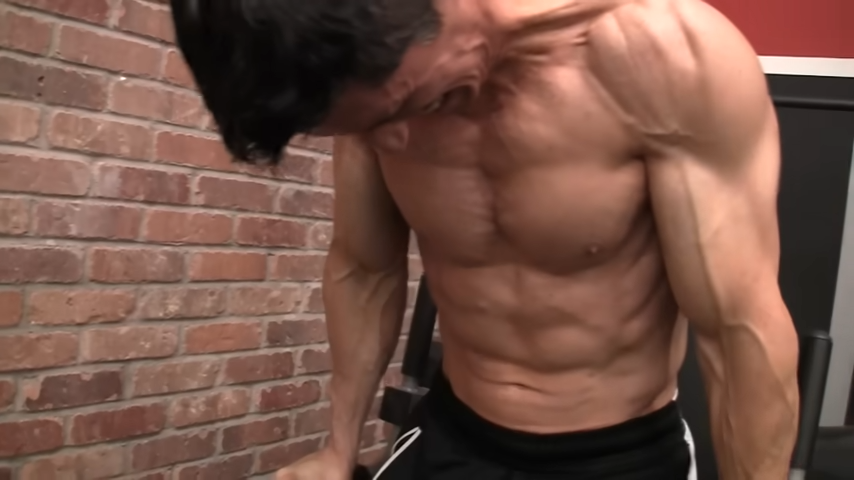
We finally get to the point where we’re actually dipping. The bottom of the dip is critical—how you push out of the bottom matters the most.
Many people tend to push straight down through their hands, making this a very vertical movement.
Instead, think about it like a bench press.
We know the value of adduction in training the chest, so let’s apply that to a fixed-handle dip.
Rather than focusing on pushing down with your hands, focus on bringing your elbows and biceps closer to your sides.
Direct your force inward, not downward.
By squeezing your biceps toward your lats on every single rep, you instantly activate your chest muscles a lot more.
This is one of those game-changer tips where you’ll feel a significant difference in your chest engagement on your very next rep.
Incorporate this technique into your Dips routine, whether you’re using a dip station, sturdy benches, or even a pull-up bar for a variation of Dips.
This method also applies to advanced Dips variations like weighted Dips with plates or a dip belt.
Maintain a stable position and take care during exercise to maximize muscle activation and avoid common mistakes that can lead to wrist pain or shoulder injury.
TOP OF THE DIP

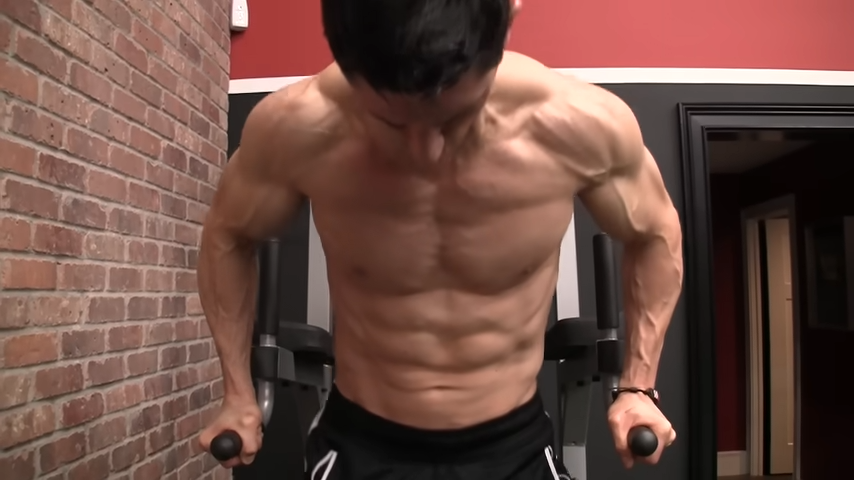
When you reach the top of the dip, don’t just focus on pushing down through the handles.
Instead, pause momentarily and try to squeeze the handles inward.
I know they’re not going to move, but this creates an isometric adduction at the top, leading to more chest activation. Then, descend back into the next rep.
By incorporating this technique, you’re making the dip a much more effective upper-body exercise, specifically for building a bigger chest.
This approach helps shift the focus away from the delts and triceps, which isn’t our goal in this instance. We want to maximize chest engagement.
To ensure you’re getting the most out of your Dips, remember to maintain proper form and avoid common mistakes (which I’ll cover more below).
Focus on muscle activation and creating a stable position. This method not only enhances muscle gains but also builds overall upper body strength and core stability.
Incorporate these tips and techniques into your dip workout, and you’ll see a significant improvement in your chest development and overall muscle strength.
Keep your core tight, maintain the correct body position, and stay consistent with your routine for maximum results.
HOW TO DO THE DIPS EXERCISE
Now that you know the four most important points to performing the Dips exercise, we can jump into the full breakdown.
Here’s how to do the Dips exercise with both a dip station and a kitchen counter:
CHEST DIPS EXERCISE (DIP STATION)

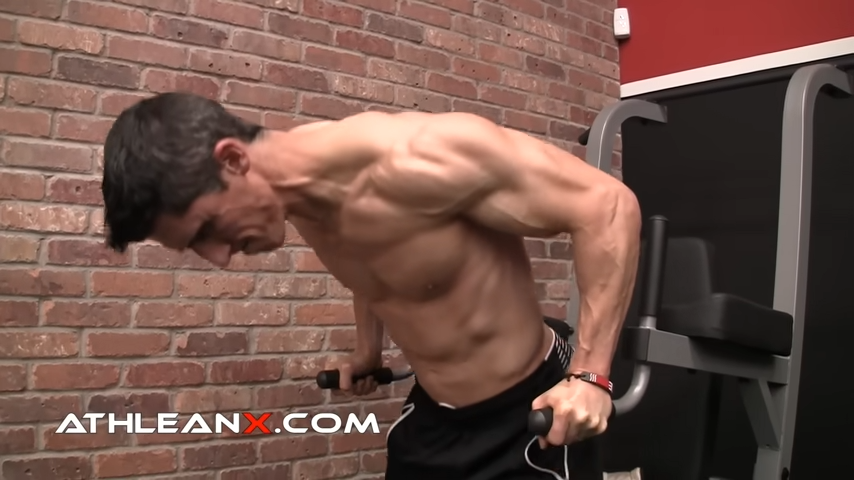
HOW TO DO IT THE CHEST DIP ON A DIP STATION:
- Begin by gripping the dip station handles firmly but comfortably. Keep your strong wrists in a neutral position to avoid wrist pain.
- Engage your core muscles and maintain an upright torso.
- Depress your shoulder blades down and back. Avoid shrugging or rounding your shoulders forward.
- Lift yourself up to the starting position with your arms fully extended. Keep your shoulders down and back, with your chest out in front of your shoulders.
- Lean slightly forward to target your chest muscles. Lower yourself slowly, bending your elbows and maintaining the slight forward lean.
- Aim to lower until your elbows form a 90-degree angle or slightly more.
- Focus on bringing your elbows and biceps closer to your sides as you descend. Direct your force inward, not downward.
- At the bottom of the dip, ensure your shoulders are still down and back. Keep your chest engaged by maintaining the forward lean.
- Push yourself back up by pressing down through your hands while squeezing your biceps toward your lats.
- Maintain the shoulder position and chest engagement throughout the movement. Return to the initial position with arms fully extended.
WHAT MAKES IT EFFECTIVE: By focusing on the proper positioning from the start, you’re able to maximize the muscle activation in your chest as opposed to surrounding muscle groups. Dips are a great chest exercise because they effectively target and engage the pectoral muscles through a full range of motion, promoting significant muscle activation and growth.
CHEST DIPS EXERCISE (AT HOME)


HOW TO DO THE CHEST DIP AT HOME:
- Find two sturdy, parallel kitchen counters or surfaces that are about shoulder-width apart. Grip the edges of the counters firmly but comfortably.
- Keep your wrists in a neutral position to avoid wrist pain.
- Engage your core muscles and maintain an upright torso.
- Depress your shoulder blades down and back. Avoid shrugging or rounding your shoulders forward.
- Lift yourself up to the starting position with your arms fully extended. Keep your shoulders down and back, with your chest out in front of your shoulders.
- Lean slightly forward to target your chest muscles. Lower yourself slowly, bending your elbows and maintaining the slight forward lean.
- Aim to lower until your elbows form a 90-degree angle or slightly more. Focus on bringing your elbows and biceps closer to your sides as you descend.
- Direct your force inward, not downward.
- At the bottom of the dip, ensure your shoulders are still down and back. Keep your chest engaged by maintaining the forward lean.
- Push yourself back up by pressing down through your hands while squeezing your biceps toward your lats. Maintain the shoulder position and chest engagement throughout the movement.
- Return to the starting position with arms fully extended.
WHAT MAKES IT EFFECTIVE: Kitchen counter chest Dips are an effective exercise because they allow you to target and engage the chest muscles using common household surfaces, providing a versatile and accessible way to build upper body strength and muscle.
DIPS EXERCISE: COMMON MISTAKES
When it comes to chest Dips, there are two common mistakes people make with their shoulders that can significantly impact their form and effectiveness.
Let’s break these down so you can avoid them and get the most out of your dip exercises.
SHRUGGED SHOULDERS
You’ll often see people doing their Dips with their shoulders shrugged up, and they keep them that way throughout the entire exercise.
This is a major mistake.
When your shoulders are shrugged, your chest is at a mechanical disadvantage and can’t contribute effectively.
This position causes your chest to stay more dormant, reducing muscle activation and making the exercise less effective.
To fix this, focus on keeping your shoulders down and back, similar to the proper position for a Bench Press.
This will engage your chest muscles more and improve your overall upper body strength.
ROUNDED SHOULDERS
The second common mistake is allowing the shoulders to round forward, especially when they are shrugged.
This creates a vulnerable position for the shoulder joint, shifting all the force into the anterior capsule of the shoulder.
Not only is this unhealthy, but it also puts the chest at a further mechanical disadvantage.
To correct this, set your shoulders back and down, creating a stable position from which to press.
This will shift the load back to your chest, allowing it to do more work and reducing the risk of shoulder injuries.
When performing Dips, it’s crucial to resist the natural tendency to let your weight sink and your shoulders rise.
As soon as you grab the bars, hold your shoulders down and keep them there throughout the entire exercise.
This isn’t easy, but it’s necessary to ensure you’re targeting the right muscles and avoiding common technique mistakes.
Focus on pushing down as you come up from the dip, maintaining a stable and effective position for your chest to engage fully.
INCOMPLETE RANGE OF MOTION
Another common mistake is not using the full range of motion.
Many people only dip halfway down, which limits the effectiveness of the exercise.
To maximize muscle activation, lower yourself until your elbows form a 90-degree angle or slightly more.
This ensures you are working your chest, triceps, and shoulder muscles through their full range, leading to better strength and muscle gains.
IMPROPER BODY POSITION
Incorrect body positioning, such as leaning too far forward or staying too upright, can also reduce the effectiveness of Dips.
Leaning too far forward places excessive strain on the shoulders, while staying too upright shifts the focus to the triceps instead of the chest.
Aim for a slight forward lean with your torso upright and core tight to properly target your chest muscles.
LACK OF CORE STABILITY
Not engaging your core muscles can make you unstable during Dips.
A stable core helps maintain proper form and balance, reducing the risk of injury.
Keep your core tight throughout the entire exercise to support your upper body and ensure smooth movement.
OVERLOADING TOO SOON
Using too much weight too soon, whether with a dipping belt, weighted plates, or additional plates, can compromise your form.
It’s essential to master the bodyweight movement first before progressing to more challenging variations.
Gradually increase resistance as your strength improves to avoid injuries.
IMPROPER GRIP
Your grip on the dip bars can affect your form and effectiveness.
Gripping too tightly can lead to wrist pain and restrict movement.
Instead, maintain a firm but comfortable grip, with wrists in a neutral position to allow for a natural range of motion and reduce the risk of wrist pain.
Dips are one of the best exercises for developing your chest, but only if you do them right.
I want you to really take your time with those four points from above and walk yourself through each step of how to do the Dips exercise until you have the form down.
Then you can add Dips back into your upper body workout program.
If you’re looking for comprehensive programs that integrate exercises at the optimal times, explore our collection of ATHLEAN-X workouts.

- Dips are a compound, body-weight exercise and an excellent movement for developing your chest, but there are four things that most people get totally wrong when they are performing the Dips exercise.
- Here’s how to correct them:
- Ensure your chest is positioned in front of your shoulders by sliding your body forward and maintaining an anterior tilt, similar to performing a suspended pushup, to maximize chest activation and minimize shoulder strain.
- Set your shoulder blades in the proper position by depressing them at the top and keeping them there throughout the exercise to enhance stability and prevent shoulder injuries.
- At the bottom of the dip, focus on bringing your elbows and biceps closer to your sides and directing your force inward to engage your chest muscles more effectively, rather than pushing straight down.
- When you reach the top of the dip, pause momentarily and squeeze the handles inward to create an isometric adduction, further activating your chest muscles and making the exercise more effective.
DIPS EXERCISE FAQS
Dips are an incredibly effective form of upper body exercise because they target and engage the chest muscles through a full range of motion, maximizing muscle activation and growth. They also help to strengthen the triceps and shoulders.
To get the most out of your Dips, follow these key tips:
Position Your Chest: Before you begin, make sure to position your chest out in front of your shoulders and maintain a slight forward lean to maximize chest activation and prevent shoulder strain.
Stabilize Your Shoulders: Depress your shoulder blades down and back to stabilize your shoulders and minimize the risk of injury. Avoid letting your traps ride up towards your ears.
Push Out of the Bottom: Focus on bringing your elbows and biceps closer to your sides and directing your force inward rather than downward to effectively engage your chest muscles.
Top of the Dip: At the top of the dip, pause and squeeze the handles inward to create isometric adduction, further activating your chest muscles and enhancing the exercise's effectiveness.
By incorporating these techniques, Dips become a powerful upper-body exercise that builds significant strength and muscle in the chest, triceps, and shoulders.
Dips are a classic bodyweight exercise that intensely engages your chest. Think of Dips as doing Push-Ups while suspended in the air, offering a greater range of motion and muscle activation.
Push-Ups target many of the same muscles as Dips, including the chest, triceps, and core muscles. They are versatile and can be performed anywhere, making them perfect for a quick, effective workout.
It’s not about which is better but how you use both for maximum strength and muscle gains.
Dips complement Push-Ups by targeting muscles from different angles and with varying resistance, offering a comprehensive upper-body workout. Dips require more upper-body strength and grip strength, while Push-Ups are excellent for building foundational strength and endurance.
Incorporate both Dips and Push-Ups into your training regimen for complete upper-body strength.
Use Dips for muscle growth and advanced exercise resistance and Push-Ups for versatility and foundational strength.
Maintain proper form, engage your core muscles, and consult resources like the American Council on Exercise or a strength coach or personal trainer to refine your technique and avoid common mistakes.
Dips are a powerful body pressing exercise that targets your entire upper body, engaging multiple muscle groups for maximum strength and muscle gains.
Engages Major Muscle Groups: Dips primarily target the chest, triceps, and shoulders, making it effective for building upper-body strength and involving the triceps brachii muscles for enhanced arm strength.
Enhances Core Stability: Performing Dips requires a tight core to maintain stability, constantly engaging your core muscles throughout the exercise.
Increases Muscle Activation: Dips offer a greater range of motion, resulting in higher muscle activation, especially in the chest and triceps. Advanced techniques like Weighted Dips can further increase resistance and activation.
Versatility and Variation: Dips can be done using various equipment like dip stations, weight benches, or kitchen counters, and can include variations like Cross Bench Dips or using a dip assistance machine.
Complements Other Exercises: Dips complement other bodyweight and weight-based exercises like the Bench Press and Bicep Curls, enhancing the effectiveness of comprehensive workouts.
Builds Maximum Strength: Incorporating Dips into your workout routine helps achieve maximum strength and muscle gains, suitable for all fitness levels with scalable resistance.
Absolutely, you can build muscle with Dips, and here's why they're one of the most effective exercises for muscle growth.
Dips primarily target your chest, making them a powerful bodyweight arm exercise. By leveraging your entire weight, you maximize muscle activation, particularly in the pectorals and triceps.
They also provide a greater range of motion compared to many other exercises. This increased active range enhances muscle activation, especially when you maintain excellent form and avoid common mistakes like locked elbows or improper shoulder positioning.
Whether you're using a dedicated dip station, weight benches, or even a cable station, Dips can be adapted to your fitness level.
REFERENCES

Jeff Cavaliere M.S.P.T, CSCS
Jeff Cavaliere is a Physical Therapist, Strength Coach and creator of the ATHLEAN-X Training Programs and ATHLEAN-Rx Supplements. He has a Masters in Physical Therapy (MSPT) and has worked as Head Physical Therapist for the New York Mets, as well as training many elite professional athletes in Major League Baseball, NFL, MMA and professional wrestling. His programs produce “next level” achievements in muscle size, strength and performance for professional athletes and anyone looking to build a muscular athletic physique.































